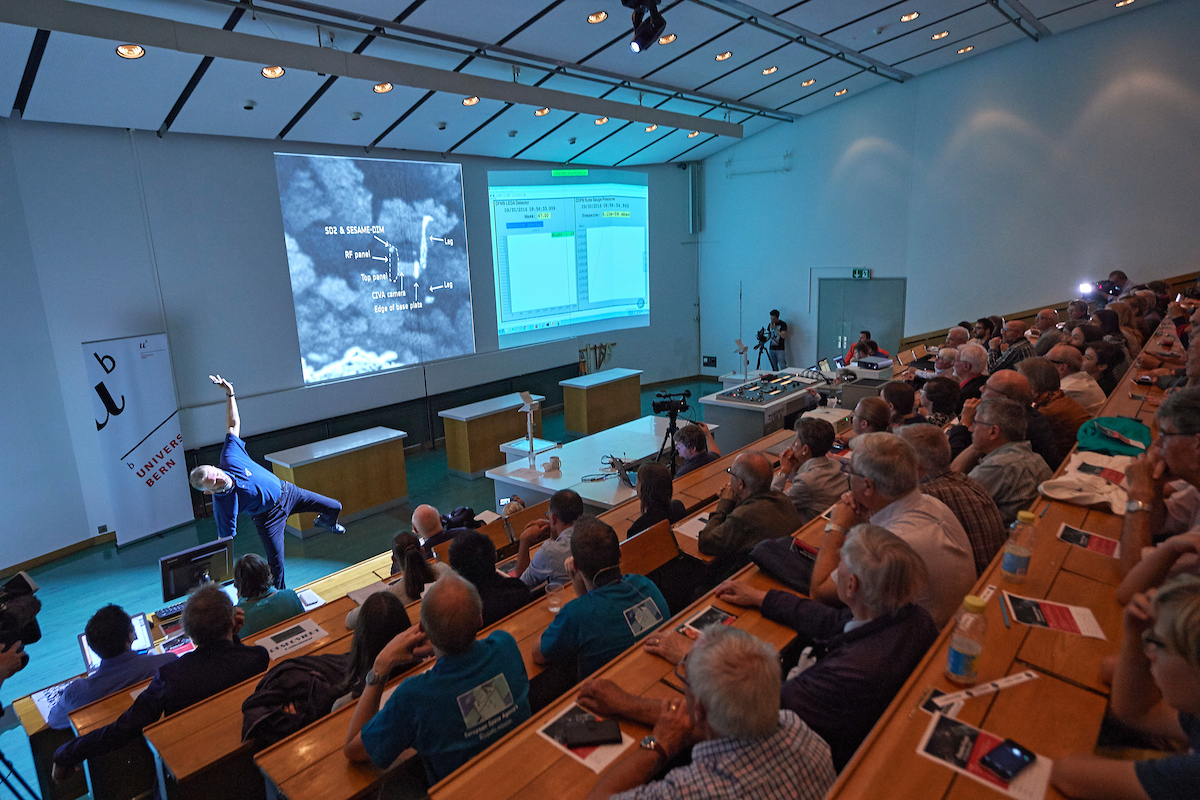Rosetta’s momentous end
Rosetta’s mission is over: After the last signal at 13:20, the spacecraft was crash-landed on comet Churyumov-Gerasimenko, with the ROSINA instrument from Bern taking measurements right until the very end. At the University of Bern, hundreds of people watched with interest as they followed the end of one of the most successful missions of the European Space Agency (ESA) live.
Rosetta’s mission took twelve years including notable firsts like the first orbit of a comet (and for 2 years no less) and, for the first time placing a lander on a comet surface. The Rosetta spacecraft has already made history.
The spectacular mission has now come to an end, with Rosetta undergoing a controlled crash on “its” comet. As the comet moves away from the sun, the energy available to the solar-powered spacecraft was decreasing. Consequently, ESA decided to crash-land the spacecraft on the comet. Rosetta therefore followed its landing probe “Philae” and now still circles the sun in its “final resting place”. The successful conclusion was also celebrated and followed in Bern – with a live broadcast of the “Rosetta Finale” from the ESA Operations Centre in Darmstadt (Germany), with a look back at the highlights of the mission and a competition. Vice-Rectors Bruno Moretti and Daniel Candinas were present for the occasion, joining those involved in the project – including those from the very first hours – and guests from the government and industry, plus numerous “Rosetta fans”.
ROSINA worked until the very end
The performance of the Bern measuring instrument ROSINA, which provided crucial information about the comet with its two mass spectrometers and pressure sensor, was also celebrated. ROSINA’s objective was to find out whether comets contain the basic elements of life, such as organic molecules and water. The yield was enormous: “ROSINA has discovered over 60 molecules, 34 of which had never been found before on a comet”, said André Bieler from the Center for Space and Habitability (CSH) of the University of Bern. Back in 2014, ROSINA was already answering key questions by, for instance, establishing that the water on Earth was probably not brought here by comets.
The instrument also brought some surprises to light – for example, that comets contain oxygen and the amino acid glycine, a basic building block of life. Bern researchers, under the supervision of Nicolas Thomas of the CSH, also examined images of the OSIRIS camera system and mapped the surfaces of the comet in detail. They were able to define over 25 distinct regions with different morphologies; these include steep slopes, large depressions, and small cavities from which material seems to flow, and flat-looking areas that display similar features to sand dunes.
During the 14-hour descent, ROSINA sent uninterrupted data, until the last signal was received from Rosetta at 13:20. The ROSINA principal investigator, Kathrin Altwegg, stayed at the official celebration at the European Space Operations Centre in Darmstadt and was connected live to Bern. She had been involved in the project since 1994, so it was a definitive moment for her: “I feel a little melancholic. But it is a colossal end!"
Work is yet to be done for several years
The end of the Rosetta mission does not mean the end of the analysis – far from it: “So far, only around five per cent of the ROSINA data has been analysed, so there is still a lot to be done”, said Martin Rubin from the Physics Institute, Space Research and Planetology division. The ROSINA team will be busy carrying out analyses for around six years under Martin Rubin, Senior Team member. According to the researchers, many more discoveries are to be expected. The last uninterrupted ROSINA measurements alone, recorded over 20 kilometres up until the impact, will provide an unprecedented plethora of data about the cloud of gas and dust surrounding the comet.
2016/09/30
A choice of ROSINA Media releases
- ROSINA Factsheet
- Surprising Discovery of Oxygen in Comet's Atmosphere (PDF, 129KB)
- Rosetta’s mass spectrometer ROSINA detected argon at comet Churyumov-Gerasimenko (PDF, 131KB)
- Comets: Soft shell, hard core? (PDF, 172KB)
- Comet probe detects the «most wanted molecule» (PDF, 128KB)
- ROSINA restarts debate on origin of Earth’s oceans (PDF, 91KB)
- The perfume of the comet (PDF, 110KB)

